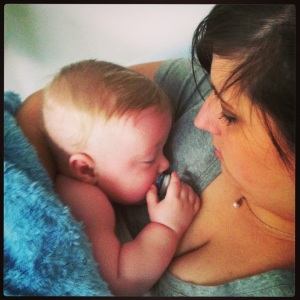If you follow me on Facebook, you know that Elliot recently underwent surgery. In person I have always been really up front about why Elliot had to have surgery when people have asked me, but for some reason I never put it on Facebook. I guess it was mostly because it can be long to explain, but also because I don’t want to make a habit of talking about my son’s genitals on FB.
When Elliot was born, Jason and I still had not decided whether or not we would circumcise. Jason wanted to, but I did not. However, when Elliot came, the nurses told us that it seemed he was born with a “natural circumcision.” I had no idea that was even possible. After the pediatrician examined him, he came to speak with us and told us that a “natural circumcision” doesn’t exist, and that what Elliot actually had was a condition called Hypospadias.
Hypospadias is a birth abnormality in which the opening of the urethra is located on the under surface of the penis rather than on the tip. Currently, it occurs in about 4 out of every 100 male births. That is a major increase from just a few decades ago. The following graph, published in 2002, tracks how common hypospadias has become.

Though the cause is mostly unknown, doctors suspect that hormone treatment during pregnancy may be a factor. That makes sense in our case because I have hypothyroidism, and we had trouble keeping my levels balanced throughout my pregnancy.
There are different degrees of severety when it comes to hypospadias. Elliot’s hypospadias was “Distal”. You can check out the diagram below to see the different degrees.

Symptoms in hypospadias are almost nonexistent in newborns. Problems can occur in later in life during puberty and adulthood if it is not corrected. However, hypospadias correction is extremely effective and long-term effects are extremely rare.
So how is it corrected? The most common corrective surgery involves using the foreskin to redirect the urethra and give it a proper opening at the tip of the penis. Complications are more likely to occur in children and adults, so most often Doctors will try to perform the corrective surgery during the child’s first year of life. After the corrective surgery, the child would be a completely normal, yet circumcised, fully functional male.
For Elliot, this meant surgery at 8 and a half months old. It would be a lie if I said I wasn’t completely freaking out in the weeks leading up to the surgery. There’s nothing more terrifying than the thought of your child being hurt. I was mostly afraid of the anesthesia he would be under, and of the pain he would go through during his recovery.
The actual surgery was no big deal. It was an outpatient procedure and we ended up only being at the hospital for 4 hours. The actual surgery took less than 45 minutes. Elliot did really well for the entire thing, charming the nurses and being playful. Even when they took him back to the OR and I choked back tears, Elliot just smiled and held his chart as the nurse carried him through the doors.
When it was all said and done, we were taken back to a recovery room where Elliot was beginning to wake up from the anesthesia. He looked so tiny in the hospital bed, and he was snuggled up in blankets and pillows. (Side note to this- I was SHOCKED that the nurses laid him in all those pillows and blankets. Ever heard of SIDS!?)
I scooped Elliot up into my arms and rocked him in the rocking chair. He was still pretty out of it, but he drank about half a bottle. After that he started opening his eyes a bit and looking around. He was really calm and collected for how confused he must have been! I snuggled him while the nurse talked us through how to care for him, the medicine he’d be on, and what to look out for. She also told us how to care for his catheter, and she made an appointment for us to come back in 6 days to have it removed.
When it came to the actual recovery, Elliot has done really well. We had to do what the doctor called “compression” diapers. Basically what that meant is that we needed to keep pressure on his penis until the swelling and bleeding stopped. We did that by folding up a washcloth, spreading a thick layer of Vaseline on it, and then putting that between him and the diaper. After two days, we stopped the compression diapers and went to regular diapers with Vaseline. His stitches dissolve on their own, so there wasn’t much to worry about, other than the catheter.
He had his catheter removed 6 days after surgery and it didn’t seem to faze him. By that point, he was looking much much better. His testicles are quite bruise, but that is to be expected.
He will go back to the doctor at one month to check that everything still looks ok. The most common complication with this surgery is that the stitches will not close the skin completely and there will be multiple urethra openings. If that is the case, the fix is pretty simple, but will require another small surgery and recovery period. Fingers crossed that this isn’t the case!
DISCLAIMER: If you have any questions about hypospadias, the surgery, or the recovery, please feel free to comment and I’ll do my best to answer! However- I am no expert and can only speak from experience. If you think your child may have hypospadias, consult your pediatrician or a pediatric urologist.


